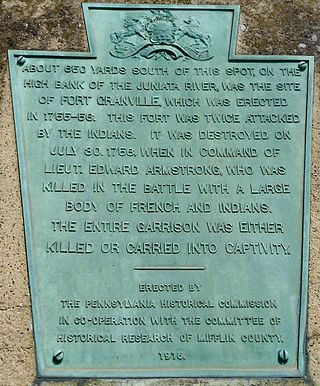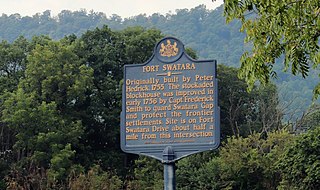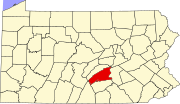
Shirleysburg is a borough in Huntingdon County, Pennsylvania, United States. The population was 150 at the 2010 census.

Kittanning was an 18th-century Native American village in the Ohio Country, located on the Allegheny River at present-day Kittanning, Pennsylvania. The village was at the western terminus of the Kittanning Path, an Indian trail that provided a route across the Alleghenies between the Ohio and Susquehanna river basins.

The Juniata River is a tributary of the Susquehanna River, approximately 104 miles (167 km) long, in central Pennsylvania. The river is considered scenic along much of its route, having a broad and shallow course passing through several mountain ridges and steeply lined water gaps. It formed an early 18th-century frontier region in Pennsylvania and was the site of French-allied Native American attacks against English colonial settlements during the French and Indian War.
Manada Gap is an unincorporated community in East Hanover Township, Dauphin County, Pennsylvania, United States, located in the Harrisburg-Carlisle area, near Fort Indiantown Gap.
Anne Rowe Hupp was an American frontierswoman of the Buffalo Creek Valley in Washington County, Pennsylvania. She led the defense of a small, isolated fort, Miller's Blockhouse, against a Shawnee attack, for more than twenty-four hours in 1782 while she was eight months pregnant.
The Battle of Sideling Hill was an engagement in April 1756, between Pennsylvania Colonial Militia and a band of Lenape warriors who had attacked Fort McCord and taken a number of colonial settlers captive. The warriors were taking their captives back to their base at Kittanning when they were ambushed by the militia, but with the help of reinforcements, the Lenape fought off the militia and escaped. The battle is significant because it was the first engagement involving Pennsylvania Militia after Braddock's defeat.

Fort Granville was a militia stockade located in the colonial Province of Pennsylvania. Its site was about a mile from Lewistown, in what is now Granville Township, Mifflin County. Active from 1755 until 1756, the stockade briefly sheltered pioneer settlers in the Juniata River valley during the French and Indian War. The fort was attacked on August 2, 1756, by a mixed force of French troops and Native Americans, mostly Lenape warriors. The fort’s garrison surrendered the strongpoint to these attackers, who celebrated their victory and destroyed the stockade.

Fort Shirley was a military fort located in present-day Shirleysburg, Pennsylvania. It was built in 1755 by George Croghan and later maintained by the Province of Pennsylvania during the French and Indian War. Fort Shirley was part of a defensive line of forts built in Pennsylvania during 1755 and 1756, at the start of hostilities with the French and their allied Native Americans. Although two French and Native American war parties were sent to capture it, Fort Shirley was never attacked. The fort served as the launching site for the Kittanning Expedition in September 1756, after which it was abandoned.
Fort Hyndshaw was a fort in Middle Smithfield Township, Monroe County, Pennsylvania, built in 1756. It was the northernmost of a line of Pennsylvania defenses erected during the French and Indian War. The fort was abandoned by its militia garrison in July 1757, but was still used by local settlers as a refuge from Native American attacks, until June 1758 when it was captured by Native American warriors and its inhabitants were taken prisoner.

Fort Depuy, sometimes referred to in contemporary documents as Depui's Fort, Dupui's Fort, and various other spellings, is a fortified homestead located in Shawnee on Delaware, a village in Smithfield Township. It was one of many forts in Colonial Pennsylvania built in 1755 and 1756 during the French and Indian War following a series of attacks on local communities by Native Americans in December 1755. The fort never saw military action and was garrisoned from early 1756 until February 1757. After this, the fort was used only intermittently until the garrison was withdrawn to participate in the Forbes Expedition in May 1758. The fort was formally returned to the Depuy family in 1763.

Fort Swatara was a stockaded blockhouse built during the French and Indian War in what is now Lebanon County, Pennsylvania. Initially a farmstead surrounded by a stockade, provincial troops occupied it in January 1756. The fort safeguarded local farms, but a number of settlers were killed by small Native American war parties. The fort was abandoned in May 1758.
Fort Lyttleton, also known as Fort Littleton, was a militia stockade located in the colonial Province of Pennsylvania. Its site was about a mile from Fort Littleton, Pennsylvania, near Dublin Township, in what is now Fulton County, Pennsylvania. Active from 1755 until 1763, the stockade was initially garrisoned by 75 Pennsylvania troops but at times had as many as 225. It was in use until 1759, then abandoned and reoccupied briefly in 1763 during Pontiac's War.
Fort Bigham was a privately built stockaded blockhouse fort constructed in 1754 near present-day Honey Grove in Tuscarora Township, Juniata County, Pennsylvania. It was built by Samuel Bigham on his land to protect his family and neighbors from Indians. In June, 1756 the fort was attacked and the people in it, mostly women and children, were all captured or killed. The fort was largely destroyed. It was rebuilt in 1760 and abandoned in 1763.

The Great Cove massacre was an attack by Shawnee and Lenape warriors led by Shingas, on the community of Great Cove, Pennsylvania on 1 November 1755, in which about 50 settlers were killed or captured. Following the attack, settlers returned to the community to rebuild, and the Provincial Council of Pennsylvania began constructing a chain of forts and blockhouses to protect settlers and fend off further raids. These forts provided an important defense during the French and Indian War.

The Gnadenhütten massacre was an attack during the French and Indian War in which Native allies of the French killed 11 Moravian missionaries at Gnadenhütten, Pennsylvania on 24 November 1755. They destroyed the mission village and took one woman prisoner, and only four of the sixteen residents escaped. Following the attack, Benjamin Franklin was commissioned by the Pennsylvania Provincial Council to construct forts in the area, and in other parts of the Province of Pennsylvania, to defend against Native American attacks, which were becoming increasingly frequent due to the French and Indian War.
Fort Henry was a stockade fort built in early 1756 in Berks County, Pennsylvania, to protect local settlers from Native American war parties, which were raiding the area frequently during the French and Indian War. It was one of the larger forts built in a defensive line, 12-20 miles apart, intended to safeguard the more densely-populated communities of the eastern Province of Pennsylvania. It was abandoned in 1759, and then briefly put back into use in 1763 during Pontiac's War.
Fort Norris was a stockaded fort built at the orders of Benjamin Franklin in early 1756 in what is now Monroe County, Pennsylvania, following a series of attacks on local communities by Native Americans in December 1755. Construction was initiated in late January, at the same time that neighboring forts Allen, Hamilton, and Franklin were being built. The fort was named for Isaac Norris, speaker of the Pennsylvania Provincial Assembly, who was a member of the planning committee charged with designing defenses in preparation for the French and Indian war. Located about fifteen miles east of Fort Allen, it was one in a chain of defensive posts running from the New Jersey border, southwest to the Maryland border, when attacks on settlements were frequent at the beginning of the French and Indian War. The fort never saw military action and was abandoned in late 1758.
Fort Hamilton was a stockaded fort built during the French and Indian War to protect Pennsylvania settlers in the area of what is now Stroudsburg, Pennsylvania. The fort was named for James Hamilton, former Mayor of Philadelphia, and former and subsequent Deputy Governor of the Province of Pennsylvania. The fort never saw military action and was abandoned in 1757.

In December 1755, the Northampton massacre was a series of attacks on people in Northampton County, Pennsylvania. These attacks terrified the population, who then demanded military protection from the Pennsylvania government. On 10 and 11 December, a party of Native American warriors attacked the Hoeth family farm and killed Frederick Hoeth and his wife, and took three of their children captive. They also set fire to Daniel Brodhead's Plantation, and attacked and burned about a dozen farms in the area. The Moravian mission at Dansbury was also destroyed.













